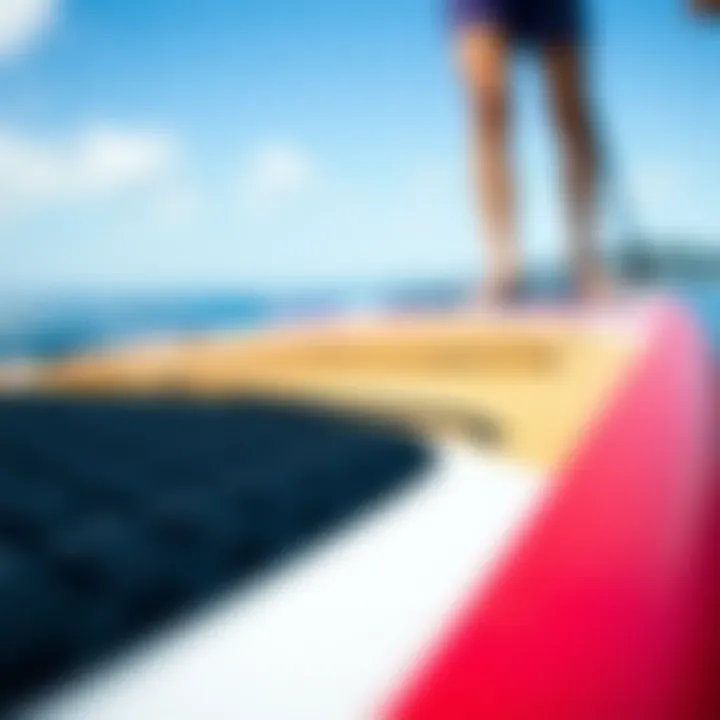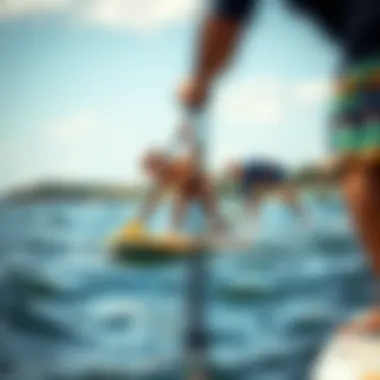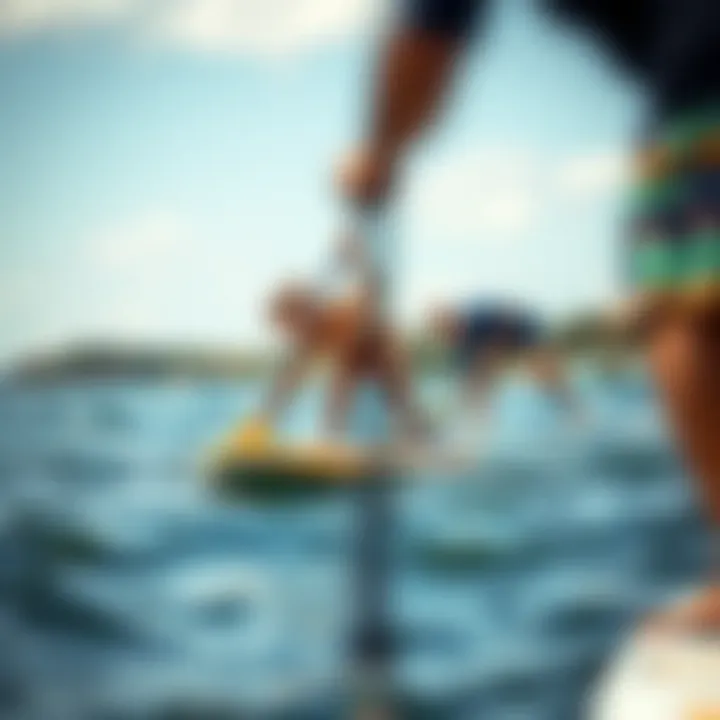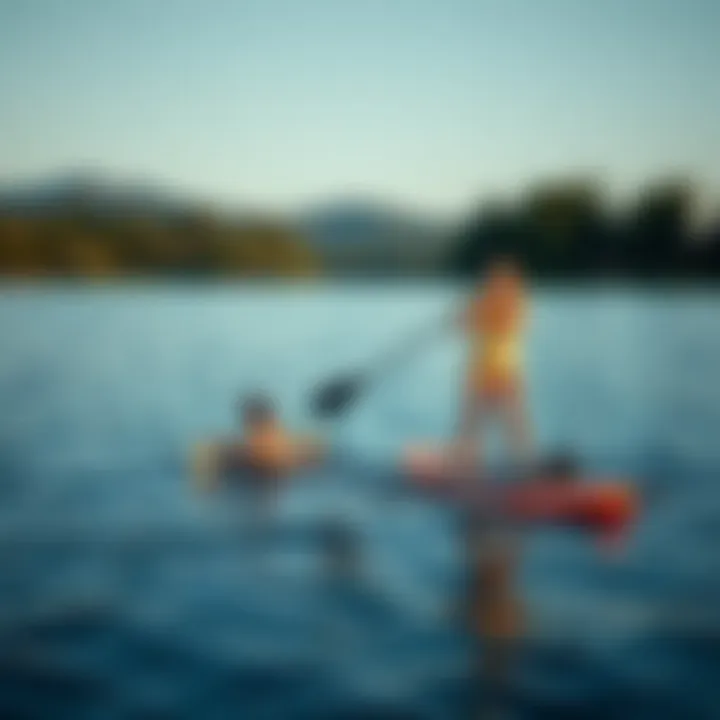Guide to Paddle Boards for Heavier Riders


Intro
In the world of paddleboarding, finding the right board is akin to choosing the right pair of shoes; it can make or break your journey on the water. With paddleboarding gaining momentum as a favored pastime, it becomes crucial to ensure that everyone, regardless of size or weight, has access to a pleasurable experience. This guide focuses on the unique considerations for heavier riders, aiming to empower those who might feel unsure about their options. By diving into critical aspects like board weight capacity, dimensions, and materials, this comprehensive overview equips athletes and recreational paddlers with essential knowledge to make informed choices.
Whether you're looking to glide peacefully across serene lakes or tackle choppy ocean waves, understanding the fundamentals of paddleboards designed specifically for fuller-bodied individuals is vital. We'll not only discuss how to select the right equipment but also explore practical paddleboarding styles tailored to heavier riders. Armed with these insights, enthusiasts and beginners alike will find themselves more prepared to venture out onto the water with confidence.
Expert Insights
Latest Trends in Watersports
With the rise in popularity of paddleboarding, manufacturers are creating boards that meet the diverse needs of riders. Lately, there's been a notable shift towards producing wider boards that offer increased stability. Riders seeking enhanced buoyancy will benefit from models designed with high-volume profiles, allowing better performance and comfort. Innovations in materials like lightweight composites are also making waves, giving boards better durability without compromising weight capacity. Overall, it’s all about striking a balance between performance, safety, and enjoyment on the water.
Safety Protocols and Best Practices
When paddleboarding, especially for heavier riders, safety should always come first. Here are some important guidelines to consider:
- Choose the right board: Ensure that the board’s weight capacity exceeds your weight to maintain balance.
- Wear a life jacket: It's a smart choice for all levels, particularly if venturing into open waters.
- Stay aware of your surroundings: Keep an eye on weather conditions and other watercraft to avoid mishaps.
- Practice proper paddling techniques: This not only aids in control but also enhances the overall experience.
"Safety isn't just a protocol; it’s a mindset that ensures enjoyment and confidence on the water.”
Equipment Recommendations
Must-Have Gear for Beginners
For those just starting out in paddleboarding, having the right gear can significantly impact your learning curve. Here are some essentials:
- Paddle Board: Opt for a wider board that provides maximum stability.
- Paddle: Look for an adjustable paddle that fits your height comfortably.
- Leash: A crucial safety item that keeps you connected to your board.
- Life Jacket: Always wear one to ensure you’re protected in case of a fall.
- Sunscreen: Protect your skin, as the sun can be relentless out on the water.
Advanced Equipment for Pros
Once you've gained confidence and skill, consider upgrading to more specialized gear:
- High-Performance Paddle Board: Boards designed for specific activities, be it racing or touring.
- Lightweight Paddles: Investing in carbon fiber paddles can enhance your efficiency.
- Hydration Pack: Staying hydrated during long paddle sessions is essential, and these packs allow for hands-free sipping.
- GoPro or Similar Device: Capture your adventures on the water with a durable action camera.
Exploring the dynamic world of paddleboarding can ignite a passion that transcends mere recreation. By focusing on the unique considerations for heavier riders, this guide aims to pave the way for safer and more enjoyable experiences on the water.
Understanding Paddle Boarding and Its Appeal
Paddle boarding has taken the world by storm, transforming from a niche water sport to a widespread recreational activity enjoyed by people from all walks of life. Among its enthusiasts, heavier riders are discovering the joy of gliding across water while surrounded by nature. This article focuses on addressing the specific needs of these individuals, ensuring they have the right equipment and insights to fully appreciate paddle boarding.
The appeal of paddle boarding lies in its versatility. It can be enjoyed on calm lakes, rivers, or even in ocean waves. This adaptability attracts a diverse range of paddlers, from those seeking tranquility to adrenaline junkies wanting to ride the surf. Beyond the physical exercise, paddle boarding offers a meditative experience; the rhythmic motion of paddling can clear one's mind, promoting relaxation and mindfulness.
But what really draws people in? It's the chance to be one with nature, basking in the sun while the gentle waves lap at the board. Many find this angle of immersion into the outdoors invigorating, especially for those who may not feel comfortable in other water sports. Moreover, paddle boarding is also a social activity, where friends and families can congregate, making cherished memories together.
In recent years, the inclusivity of paddle boarding has become crystal clear. People of varying sizes and body types can participate, making adjustments and selecting appropriate boards essential for safety and enjoyment. Understanding the specific challenges faced by heavier riders allows us to create a more inviting experience, ensuring they can enjoy every moment on the water.
Preamble to Paddle Boarding
Paddle boarding, also known as stand-up paddleboarding (SUP), originated in Hawaii as a way for surf instructors to observe their students in the water. It quickly evolved into a popular sport and recreational activity worldwide. Paddlers stand on a large board and use a long paddle to propel themselves forward, allowing for an engaging full-body workout that builds strength, balance, and coordination.
Advancements in technology have also made paddle boards more accessible. From inflatable boards that can be easily transported to rigid designs that offer optimal stability, there's something for everyone. This wide-ranging selection caters to various rider sizes, skill levels, and preferences.
Factors Influencing Popularity
The growth in paddle boarding can be attributed to several factors:
- Accessibility: Many locations offer rental services, making it easy for newcomers to test the waters without a significant investment.
- Low Learning Curve: Unlike surfing, which requires more skill to master, paddle boarding is relatively straightforward, allowing beginners to find their footing quickly.
- Fitness Benefits: As health trends gain momentum, more individuals seek activities that combine fun and exercise. Paddle boarding checks both boxes, making it appealing for those keen on staying active.
- Community: Online forums and local clubs foster a sense of belonging among paddlers. Sharing experiences and tips has helped build a supportive environment where individuals feel encouraged to dive into the sport.
- Scenic Exploration: The ability to discover new places from an engaging perspective continues to attract adventurers and nature lovers alike.
Overall, understanding the appeal of paddle boarding sets the stage for how it can be beneficial and enjoyable for heavier riders. Ensuring comfort and safety on the water is a priority, and with the right information and gear, everyone can experience the joys of paddle boarding.
The Significance of Size and Weight in Paddle Boarding
Paddle boarding, while open to everyone, brings unique challenges and considerations for heavier riders. When it comes down to it, the size and weight of both the paddler and the board can significantly affect the experience on the water. Understanding these factors helps in choosing a suitable paddle board, ensuring it provides stability, safety, and ample enjoyment.
Understanding Weight Capacity Limitations
Weight capacity is a crucial aspect of paddle boarding, especially for those who weigh more. It’s vital to choose a board that can handle your weight plus any gear you might be carrying, such as a cooler or backpack. Generally, each paddle board is equipped with a weight limit specified by manufacturers. This limit encompasses the rider's weight along with additional gear. Exceeding this limit can lead to instability and even capsizing.


"Paddle boards have no room for play when it comes to weight limits. Choose wisely, or you're courting trouble on the water!"
For heavier individuals, a board with a higher weight capacity not only improves performance but also guarantees safety. Having a proper weight allowance leads to a better buoyancy level, enabling the rider to stay above water. As a general rule of thumb, you should select a board whose weight capacity exceeds your own by at least 20% to account for any unforeseen factors.
Board Dimensions and Stability
The dimensions of a paddle board—length, width, and thickness—play a pivotal role in ensuring a stable ride. For heavier riders, opting for a board that is wider and thicker can vastly improve the experience. A wider board offers a bigger surface area, which translates into greater stability. Being less likely to tip means you can focus on your paddling technique instead of worrying about falling in.
- Length: Longer boards typically glide better through the water while offering added stability. For heavier riders, boards between 11 and 14 feet usually suffice. Recommended options fall around 12 feet in length for an optimal balance of speed and stability.
- Width: Wider boards, measuring up to 34 inches, ensure a solid platform. The added space helps maintain balance, which is particularly beneficial when navigating choppy waters or making quick movements.
- Thickness: A thicker board (around 6 inches) increases volume, thereby enhancing buoyancy. Increased buoyancy means better performance for heavier riders.
Overall, the right dimensions are instrumental in delivering a quality paddle boarding experience. By utilizing the appropriate measurements, heavier riders can prevent uncomfortable situations, enjoy extended time on the water, and take on various water conditions with confidence.
Choosing the Right Paddle Board
Selecting the appropriate paddle board is a crucial decision for heavier riders, one that can significantly influence the enjoyment and safety of the experience. A mismatch between rider weight and board specifications can lead to unstable rides, which might end in frustration or, even worse, potential accidents on the water.
One must consider various elements such as board type, weight capacity, and dimensions. This knowledge helps ensure a more enjoyable paddleboarding experience. When chosen wisely, the right board not only supports the rider's weight but also offers better stability and maneuverability. Factors like materials and maintenance are also pivotal in ensuring longevity and performance over time. Understanding these aspects will aid anyone in making a choice that is adequately tailored to their unique needs and skill level.
Types of Paddle Boards Suitable for Heavier Riders
All-Around Boards
All-around boards are often regarded as the jack of all trades in the paddleboarding world. They are typically wider and therefore more stable, making them an excellent choice for heavier riders. Their versatility allows for a variety of uses, from casual paddling on calm waters to tackling small waves. One notable characteristic of all-around boards is their generous weight capacity. This feature helps to accommodate larger riders, ensuring they can paddle confidently without concerns about sinking or instability.
The unique design often includes a pronounced nose and tail, enhancing glide and maneuverability, which is an advantage for navigating different water conditions. However, their general-purpose nature might not excel in specialized tasks, like high-speed touring or intense wave riding, limiting their performance in those areas.
Touring Boards
Touring boards are built for longer distances, designed to cruise efficiently across open waters. These boards are often longer and sleeker than all-around options, which can contribute to improved speed and tracking. For heavier riders, a well-constructed touring board can deliver both comfort and performance on extended paddling sessions. One feature that stands out in touring boards is their streamlined shape, which helps slice through the water efficiently, minimizing drag.
The benefit of using a touring board is the range they offer for exploring larger bodies of water. However, they may lack the immediate stability found in broader all-around boards, potentially challenging less experienced paddlers. Still, for those who prioritize distance and speed, touring boards offer a thrilling experience.
Yoga Boards
Yoga boards have gained popularity among paddleboard enthusiasts, especially those who want to practice yoga on the water. These boards are typically wider and provide a stable platform that caters to balance and poise during yoga poses. The design often incorporates padded surfaces for added comfort, which is crucial when practicing yoga for extended periods.
The key aspect of yoga boards is their stability, which allows heavier riders to confidently move through both general paddling and yoga routines. However, while these boards excel in stability, they might not perform as well in speed-focused activities or choppy water conditions. This could be a disadvantage for those who wish for a multi-purpose board but can serve as an excellent option for those finding joy in yoga practices on serene waters.
Material Considerations
Inflatable vs. Rigid Boards
When choosing between inflatable and rigid paddle boards, the decision can impact the experience significantly. Inflatable boards are often lighter and easier to transport. They can be deflated and rolled up, making them a favorable option for those with limited storage space or who frequently travel. Additionally, inflatable boards generally offer more shock absorption, which contributes to a more cushioned ride for heavier riders.
On the other hand, rigid boards are favored for their performance and durability. They often provide better speed and tracking due to their solid construction. The stability of rigid boards can be unmatched when they are constructed from high-quality materials. Each option has its pros and cons, and the right choice will usually depend on personal preference and intended use.
Durability and Maintenance
Durability is another fundamental aspect to consider when selecting a paddle board. Heavier riders, especially, should be mindful of the materials used in the board’s construction, as it determines how well the board withstands wear and tear. High-density materials, while often heavier, can offer longevity and resistance to impacts.
Regular maintenance is vital regardless of the material chosen. Checking for leaks in inflatable boards or ensuring rigid boards are free from dings and scratches can prolong the life of the equipment. It’s also vital to clean the boards after use, particularly from saltwater or sand deposits, to maintain their condition in the long term. By taking care to select durable materials and implementing a solid maintenance routine, riders can enhance their paddleboarding experience greatly.
Evaluating Features for Enhanced Experience
When it comes to paddle boarding, especially for heavier riders, understanding the specific features of your board can significantly heighten your experience on the water. These features not only affect performance but also play a crucial role in ensuring comfort and stability. As you gear up for your next adventure, it’s essential to evaluate the deck pad's comfort and the fin setup to tailor your paddle boarding experience seamlessly.
Deck Pad and Comfort
The deck pad of a paddle board is often an underrated feature, but its importance cannot be overstated. A well-designed deck pad offers a good blend of comfort and grip. This is especially crucial for heavier riders. When you are standing for extended periods, a cushioned surface can alleviate stress on your feet and legs.
Benefits of a Quality Deck Pad:
- Grip: A good grip is essential to prevent slipping, especially if you encounter choppy waters. You don't want to be losing your footing at a critical moment. Look for pads that offer textured surfaces for enhanced traction.
- Comfort: Padding that is thick enough to absorb shocks and bumps from the water will leave your feet feeling less fatigued after a long session, allowing for a more enjoyable outing.
- Thermal Insulation: On sunny days, the board can heat up. High-quality deck pads often have properties that help in mitigating excessive heat, providing a cooler surface to stand on.
When selecting your paddle board, check the deck pad material and ensure it's suitable for the type of paddling you plan to do. Longer excursions might demand a more robust and comfortable pad than a quick leisure cruise.
Fin Setup for Stability
A paddle board's fin setup plays a pivotal role in its overall stability. This element arguably makes or breaks your time on the water, especially for heavier riders who require additional balance.


Factors to Consider for Fin Setup:
- Number of Fins: Boards can have a single fin or multiple fins. While a single fin can provide a straight line speed, multiple fins often offer better stability and maneuverability, which is a valid choice if you are a heavier rider.
- Fin Size and Shape: Larger fins generally provide greater stability, an essential consideration for heavier individuals. If you have a wider stance, larger fins can help maintain balance even in rough conditions.
- Removable vs. Fixed Fins: Many boards offer removable fins, which can be adjusted or replaced based on your paddling environment. Retaining the option to customize your fin setup can be beneficial for adapting to various conditions, from calm lakes to choppy oceans.
"A well-thought-out fin setup provides the necessary control and maneuverability, helping heavier riders navigate effortlessly through waters."
Culminating these features is key to elevating your paddle boarding journey. Spending a little extra time evaluating deck pad comfort and fin setups could mean the difference between a tedious outing and one filled with joy and exploration.
Techniques for Paddling Efficiently
When it comes to paddle boarding, the way you paddle can make or break your experience on the water. It's not just about getting from point A to B; it’s about enjoying every stroke and maximizing your efficiency. Proper paddling techniques are particularly essential for heavier riders, as they often face unique challenges, like maintaining balance and exerting more energy while paddling. Thus, mastering these techniques can enhance performance and make each session more enjoyable.
Stance and Posture
The way you stand on a paddle board plays a critical role in your overall paddling efficiency. Here’s a more in-depth look into stance and posture:
- Foot Position: Start with your feet shoulder-width apart and centered on the board. This positioning helps distribute your weight evenly, which is vital for maintaining balance. If you lean too far forward or back, you can tip over.
- Knees Slightly Bent: Keeping your knees slightly bent engages your core and lower body, allowing for better balance. This position can absorb the board’s movements more effectively, helping you stay upright. A rigid stance may lead to fatigue quickly and can hinder your ability to react to shifting water conditions.
- Hips and Shoulders Aligned: Keep your hips over your knees and shoulders aligned over your hips. This straight line of support allows for efficient transfer of power through your paddle strokes.
- Eyes on the Horizon: Instead of looking down at your feet, keep your gaze fixed on the horizon. This not only aids in maintaining balance but also helps you navigate effectively.
Proper posture contributes significantly to effective paddling. If your body is well-aligned, you will be less likely to tire quickly, even while paddling for longer hours.
Paddling Techniques for Optimal Performance
Once your stance is rooted, the next step involves employing effective paddling techniques that can propel you through the water with grace and efficiency. Here are several techniques to keep in mind:
- Drawing Water with Each Stroke: Begin paddling with your paddle fully submerged in the water near your feet, then push the water back towards the tail of your board. This technique ensures that you are maximizing the power of each stroke.
- Maintain a Rhythm: Finding a steady rhythm is like music; it's important. Paddling with a consistent cadence helps maintain momentum and can reduce fatigue. Avoid overexerting yourself with long, exaggerated strokes.
- Core Engagement: It might seem like paddling is all about your arms, but your core plays a pivotal role. Engaging your core while paddling allows for better power transfer from your body to the paddle. Think of your core as the engine that drives your strokes.
- Utilize Your Entire Reach: Extend your paddle as far forward as possible without losing balance before pulling it through the water. This technique helps to maximize each stroke’s distance and efficiency.
- Turning Techniques: Don’t forget how to turn. Use a sweep stroke by reaching your paddle wide out to the side of your board rather than just turning your body. This technique helps provide leverage and can quicken your directional change.
By practicing proper stance and efficient paddling techniques, heavier riders can enjoy their paddle boarding adventures with improved balance and energy management. Knowing these techniques turns a casual paddle into a more enjoyable, efficient experience.
Safety Considerations and Best Practices
When one embarks on the adventurous journey of paddle boarding, safety should always remain at the forefront of one's mind. Engaging in any water-based activity introduces inherent risks, but knowing how to navigate these can elevate the experience from perilous to pleasurable. The following points concerning best practices and safety for heavier riders aim to provide not just a safe outing, but also an enriching one.
Personal Flotation Devices (PFDs)
The significance of Personal Flotation Devices (PFDs) cannot be overstated for paddle boarders, particularly for those of us who may carry extra weight. A suitable PFD acts as a removable safety cushion, ensuring buoyancy if one finds themself in unanticipated waters.
When choosing a PFD, you should consider a few key factors:
- Fit and Comfort: A PFD must fit snugly without being restrictive. Opt for one designed to support a heavier frame, with adjustable straps for that perfect fit.
- Type of PFD: There are different PFD types, such as Type III, which are great for watersports as they are less bulky and allow for free movement.
- Durability: Look for quality materials that resist wear and tear, especially if your excursions take you through rocky or rugged areas.
I cannot stress enough the importance of having your PFD on at all times while paddling. Even seasoned paddlers can unexpectedly capsize or face challenging conditions. As the saying goes, "better safe than sorry"—this applies tenfold in the watery world of paddle boarding.
Weather Awareness and Conditions
Understanding weather conditions is crucial for paddle boarders, as they are constantly at the mercy of nature's whims. Factors such as wind speed, wave height, and temperatures can drastically alter your experience on the water.
It helps to keep these points in mind when planning your outing:
- Check the Forecast: Before heading out, use reliable resources such as weather.gov or local news channels. The Marine Weather page is particularly handy for real-time water-based forecasts. When the winds rustle and the skies darken, it may be prudent to postpone.
- Wind Conditions: Strong winds can make paddle boarding feel like trying to walk through thick molasses. Gauge wind strength; anything above 10 mph can lead to difficult paddling and potential hazards, particularly on open water.
- Rough Waters: Choppy waters may challenge even the most experienced paddlers. A quick glance at the water's surface can inform you of the lake or ocean's temperament.
- Sun Protection: Don’t forget that you are likely to be out under the sun for extended periods. Apply sunscreen generously and reapply often, as water reflects the sun’s rays and intensifies exposure.
"Safety isn’t just a slogan; it’s a way of life." Consider these weather-related safety tips as vital to your paddle boarding statistics as choosing the right board is.
Enhancing Your Paddle Boarding Experience
When it comes to paddle boarding, the thrill often lies not just in the action on the water, but also in enhancing the overall experience. This section dives into what can make paddle boarding more enjoyable and tailored for heavier riders.
There are various elements to consider. Accessories like storage options and safety gear can drastically improve comfort and security while paddling. Exploring different locations can also transform a standard outing into a memorable adventure. Ultimately, these components are not just add-ons; they are essential in forging a deeper connection with the sport.
Adding Accessories
Adding accessories plays an integral role in personalizing your paddle boarding journey. With the right enhancements, riders can tackle the water more confidently and effectively.
Storage Options
Having appropriate storage options can make life on the water smoother. Whether it’s a sup bag that fits snugly on your board or a dry bag that keeps belongings safe and dry, appropriate storage is valuable for many heavy riders.
Key characteristics of storage solutions are often their durability and portability. A tough, lightweight bag, for example, can withstand splashes while being easy to carry. Such storage options often include clips and straps that make securing equipment effortless.


However, there's always a trade-off. While larger storage may hold more, it could also impact the board’s balance if poorly distributed. This consideration is crucial for heavier riders who might need to adjust their loading techniques to maintain stability on the water.
Safety Gear
Safety gear is a non-negotiable aspect of paddleboarding. It ensures that rides are as safe as they are enjoyable. For heavier riders, choosing the right personal flotation device (PFD) that conforms well to their body can make a significant difference.
The uniqueness of safety gear lies in its tailored fit. A comfortable life jacket allows for better mobility, which is vital when navigating waters. Some PFDs come with additional features such as pockets for small items or even hydration packs which are handy for longer trips.
Nevertheless, the right gear can sometimes feel bulky. Heavier riders need to strike a balance between comfort and safety—ensuring personal flotation devices are worn correctly while maintaining an enjoyable degree of flexibility.
Exploring Locations for Paddle Boarding
The backdrop of a paddleboarding adventure can elevate the experience altogether. Imagine gliding over calm lakes, serene rivers, or even challenging ocean waves. Knowing where to paddle can be as important as the board itself.
Different locations offer varied levels of difficulty and beauty, which cater to different paddling styles. For heavier riders, calm waters can be more forgiving, while windier or choppier conditions may require a bit more skill.
Some ideal locations might include:
- Lakes: Flat and usually more sheltered, they provide a great start for beginners.
- Rivers: Flowing water can offer fun currents, but caution is key with obstacles.
- Coastal Areas: Can be spectacular but often require more experience and safety preparations.
Paddle boarding can be an exceptional way to explore natural beauty, but always keep in mind personal comfort, skill level, and weight considerations to maximize enjoyment. A little research into destination characteristics can go a long way in raising the joy of the paddle boarding experience.
Common Misconceptions about Paddle Boarding and Weight
When talking about paddle boarding, a few myths float around that often skew perceptions, particularly for heavier riders. Addressing these misconceptions is essential not just for understanding how paddling works but also for fostering a more inclusive environment in water sports. Every paddler deserves to enjoy the thrill of gliding across the water, regardless of body type.
First and foremost, the idea that paddle boarding is only for the "light and lean" is one that needs to be put to rest. The reality is far more nuanced. Many boards can accommodate a variety of weights and the design of boards is continually evolving to support heavier individuals. It's crucial for both new and seasoned paddlers to break free from narrow thinking to explore the available options.
The perception that heavier riders cannot maintain stability on the water is another misconception. In fact, this idea can deter people from trying paddle boarding altogether, quite unfairly. Certain boards, especially those designed for larger riders, have better stability due to their construction and dimensions.
Debunking Myths
1. Heavier Paddlers Can't Enjoy the Sport
This simply isn't true. Many heavier riders find paddle boarding to be an enjoyable and exhilarating experience. The key is selecting the right equipment suited for their specific needs. By choosing boards that emphasize stability and buoyancy, they can have just as much fun as anyone else.
2. All Paddle Boards Are Created Equal
Many newcomers might think that any board will do for any paddler. In reality, boards vary significantly in terms of size, shape, and materials. Some are specifically crafted for heavier weight limits and provide features that enhance performance while on the water.
3. You Need to Be Experienced to Paddle Board
Paddle boarding is accessible to everyone, regardless of skill level. Instructors and rental places often offer programs and advice for beginners. You don't need to be a pro to find joy in paddle boarding; just step onto a suitable board, and you may surprise yourself.
Promoting Inclusivity in Watersports
Promoting inclusivity in watersports doesn't just help heavier individuals; it enriches the entire paddleboarding community.
- Variety in Boards: More manufacturers are beginning to produce specialized boards for heavier riders, illustrating a positive trend toward inclusivity. These boards help pave the way for greater participation among various body types. Brands like Body Glove and iRocker are keen on creating diverse designs that cater to this demographic.
- Community Initiatives: Paddleboarding organizations and local clubs are increasingly encouraging heavier riders to join in. They often hold community events and workshops focused on inclusivity, demonstrating the sport's welcoming nature.
- Education on Equipment: Educating potential paddlers about the different types of boards and their benefits can help combat misinformation. For instance, those looking for storage options may find the right inflatable board that suits their needs.
As the sport continues to grow, dispelling misconceptions and promoting inclusivity may just be the winds beneath the wings of the paddleboarding community.
"Don’t let your body size define your adventures. Paddle boarding can be for everyone."
For those looking to learn more about paddle boarding inclusivity, consider visiting recreational resources from organizations like the MWR (Morale, Welfare and Recreation) or joining forums on platforms like Reddit where real stories from fellow paddlers can offer support and insight.
Final Thoughts: The Joy of Paddle Boarding for Everyone
Paddle boarding is not just a sport; it’s an experience that transcends age, body type, or skill level. In this final section, we reflect on the essence of paddle boarding and underscore its significance as an inclusive activity for all. The aim of this article is to provide clarity around paddle boards tailored for heavier riders, highlighting key benefits while debunking myths associated with limitations of participation based on body type.
Encouraging Participation Across Body Types
One of the most compelling aspects of paddle boarding is its accessibility. There’s a common misconception that outdoor sports favor a specific body type, often leading to exclusion among individuals who don’t fit this mold. It's crucial to recognize that water activities can be enjoyed by everyone, regardless of one's weight or shape. Boards are now designed with a diverse range of riders in mind, and embracing this fact can pave the way for more participants.
- Personal Empowerment: Engaging in paddle boarding promotes a sense of empowerment and boosts self-esteem. Heavier riders find joy in realizing that they too can glide over water without fear.
- Community Aspect: There’s also a community element. Groups and social media channels where paddlers connect, like reddit.com, showcase the benefits of inclusiveness. Many heavier paddlers share personal stories, hosting meet-ups and paddle sessions that invite all body types to join.
- Physical Benefits: Paddle boarding strengthens muscles and improves balance. When more people join, the conversation shifts from what one can’t do, to the joy of movement, exploration, and fitness.
It becomes clear that fostering an environment encouraging participation leads to a richer paddle boarding culture, welcoming diversity and strenfthening community ties.
Looking Ahead in Paddle Boarding
As we consider the future of paddle boarding, it's evident that this sport is evolving. The focus on inclusivity is gaining momentum, and innovation within board designs caters to a wider audience. Future trends promise advancements that prioritize comfort, performance, and ultimately, enjoyment.
Emerging Trends
- Technology Integration: The incorporation of technology in paddle boards is on the rise, from smart boards with performance analytics to GPS systems helping navigators find the best spots. This tech-savvy approach opens doors for many.
- Sustainable Materials: There’s also a push for sustainability in the manufacturing of boards. Eco-friendly materials grow more popular, appealing not just to the paddlers' preferences but also to their values regarding nature preservation.
- Workshops and Training Programs: Organizations are laying foundations for workshops targeting different body types, creating avenues for education and encouragement.
Emphasizing readiness for change indicates a positive outlook within the paddle boarding community. The inclusivity movement is not merely a trend; it’s a shift aimed at ensuring anyone can find joy on the water. To explore more about paddle boarding and find supportive networks, resources like facebook.com groups or local sports clubs can provide additional insight and camaraderie.
Encouraging people of all shapes and sizes to embrace paddle boarding can thereby change lives.
As you sail into future paddle boarding adventures, keep in mind that your body is only a vessel for exploration. The joy is in the journey, and every effort made to widen the accessibility of this sport contributes to a more vibrant and dynamic community. Happy paddling!







